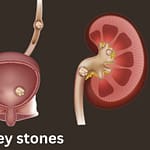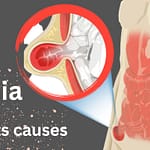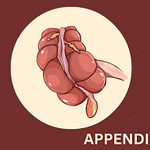
What is Deep Vein Thrombophlebitis?
In this disease, blood clots in the deep veins of the legs, causing swelling and pain in the leg.
The biggest complication in this condition is pulmonary embolism, in which a blood clot breaks
off from inside the leg vein, passes through the body, enters the right side of the heart, and gets
stuck in the pulmonary arteries, where it gets stuck several times. Death is a potential outcome
for the patient.
Deep Vein Thrombosis Causes
- If the patient is bedridden for a long time due to an illness, this illness may occur.
- This disease can occur after surgery.
- Due to high cholesterol
- An excess of red blood cells
- As a result of excess estrogen hormones, birth control pills are commonly used.
- Due to blood vessels.
Deep Vein Thrombophlebitis Symptoms
- Swelling and pain in the leg.
- mild fever
- The infected snake feels warm to the touch.
- Redness often occurs on the affected leg.
- Severe pain in the calf if the patient’s foot is raised.
- Touching the place where the actual is formed causes severe pain.
Lab Test Deep Vein Thrombophlebitis
The test done for this disease is called “venography.” In this procedure, a dye is injected into
the blood vessels of the leg, and X-rays are taken, thereby detecting clots trapped inside the
blood vessels. If in the vessels of the upper parts of the legs.
A test called IPG is done to check for tar embolisms.
Doppler Study of Veins
It is a kind of ultrasound that detects obstructions in the kidney.
Deep Vein Thrombophlebitis Treatment
This disease should be treated with medicines that reduce blood clotting. However, in
myopathy, the treatment is based on the similarity of the symptoms, so the duty of the
doctor is to take the symptoms into account, but a few drugs are mentioned below:
-
M Stiva Q
There is a benefit to using this medicine for this condition. The use of this medicine reduces the
thickness of the blood.
-
Black Peacock x 6
This medicine is also useful for the same purpose. You can take this medicine along with
any other medicine you may use.
-
Criticisms
It is the most effective medicine for cleaning blood vessels. It is also recommended that the
patient drink lemon water. There is a cycle when excess is felt near the heart.
Eid al-Adha in Nice
This medicine is one of the most effective medicines for heart disease. The patient has joint
pain, the flu, or kidney failure before any heart disorder. If there is swelling or water in the body
due to the actions of the heart, this medicine is no less than a blessing.
Leg pain phlebitis
A condition characterized by inflammation caused by blood clots inside the veins,
thrombophlebitis may occur when there are one or more clots in the vein.
Most often, this condition affects the legs, but it can also affect other parts of the body,
such as the arms. When a clot blocks blood flow in a vein, it can cause discomfort and irritation.
The disease can affect both deep and superficial veins in a person suffering from phlebitis.
In superficial phlebitis, the veins are close to the skin’s surface. In most cases,
this type of phlebitis is not serious and can be treated effectively with proper care.
It is still important to seek medical treatment as deep vein thrombophlebitis can also occur.
An individual with deep vein thrombophlebitis often has large blood vessels in the
legs affected by the disease. It can cause the formation of large blood clots that
travel to the lungs, resulting in a serious condition known as a pulmonary embolism.
If you experience symptoms of thrombophlebitis, you should seek medical
attention immediately.
Postpartum Thrombophlebitis
The condition of thrombophebitis, where blood clots form, occurs in about one
out of every 1,500 pregnancies. The postpartum period is when the three most
common thromboembolic disorders happen: deep vein thrombosis (DVT),
pulmonary embolism (PE), and superficial vein thrombosis (SVT). Blood flowing
over the clot can increase its size as platelets, fibrin, and cells are added.
The clot-dissolving factors reduce during pregnancy while the clotting factors increase,
resulting in hypercoagulability.
There is a higher risk of superficial thrombophlebitis for women with varicose veins,
which is a painless, hard, reddish, and heated vein affecting the saphenous vein of
the lower leg after childbirth. When a blood clot breaks off and lodges in the lungs,
obstructing the pulmonary artery, pulmonary embolism occurs. The symptoms of
heart failure can be sudden and severe, including chest discomfort, coughing,
shortness of breath, loss of consciousness, and fainting.
While less than 1% of postpartum women experience thromboembolic illnesses,
a pulmonary embolism can be fatal if the clot obstructs the pulmonary circulation.
Early detection and treatment are crucial. Nursing management focuses on
preventing thrombotic situations, promoting appropriate circulation, and educating
clients about precautions, anticoagulant therapy, and warning indications for thrombosis.
Superficial blood clot behind knee
In cases of venous thromboembolism, an abnormal blood clot beneath the knee causes pain,
swelling, warmth, and skin discoloration. When an intervention is quick, the risk of fatal
consequences, such as a pulmonary embolism, can be reduced. It is responsible for
transporting blood to the heart through the popliteal vein behind the knee.
Thrombosis of the popliteal vein is the result of blood clotting in this vein.
These symptoms include swelling, pain, and inflammation in the legs and knees.
A popliteal vein thrombosis can result from insufficient blood flow, damaged blood vessels,
or external injuries. There are various causes, risk factors, and symptoms associated with
popliteal vein thrombosis, as well as how to prevent, treat, and manage it.










